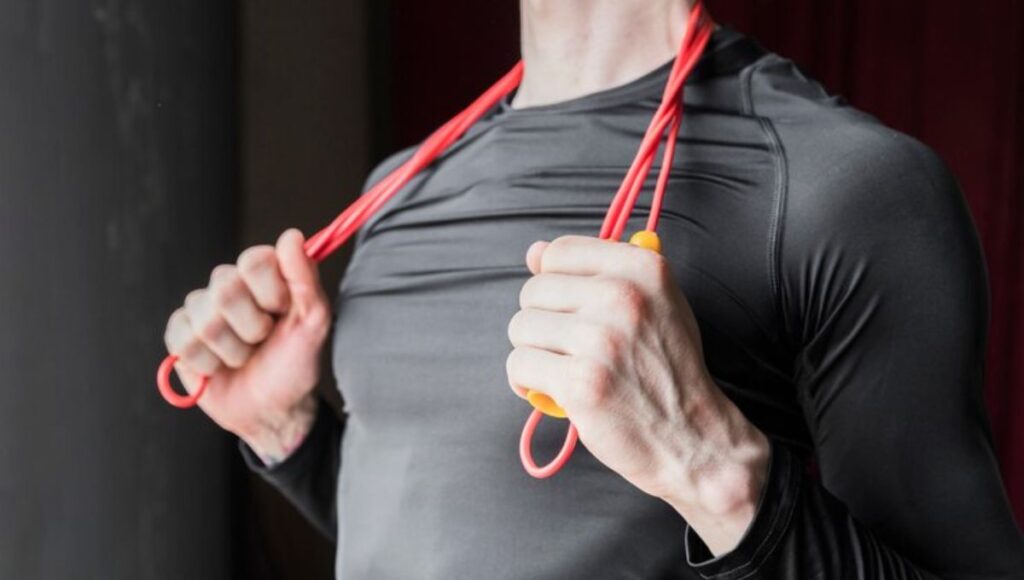Introduction:
Welcome to the definitive guide on forearm exercises with resistance bands. Strong forearms are essential not only for enhancing your grip strength but also for improving overall upper body strength and appearance. In this article, we will explore the benefits of training your forearms with resistance bands and provide you with a curated selection of the best exercises to target this often-overlooked muscle group. Whether you’re a beginner or a seasoned fitness enthusiast, this comprehensive guide will equip you with the knowledge and tools to sculpt powerful forearms anytime, anywhere. Let’s dive in and redefine your arm strength together.

1. Understanding Forearm Anatomy and Importance
Anatomy of Forearm Muscles:
The forearm is composed of various muscles that play crucial roles in wrist and hand movements. Understanding the anatomy of these muscles is essential for effective training. Key muscles in the forearm include:
Flexor Muscles:
These muscles are located on the anterior side of the forearm and are responsible for flexing the wrist and fingers. Examples include the flexor carpi radialis, flexor carpi ulnaris, and palmaris longus.
Extensor Muscles:
Situated on the posterior side of the forearm, extensor muscles facilitate the extension of the wrist and fingers. Some prominent extensor muscles are the extensor carpi radialis longus, extensor carpi radialis brevis, and extensor digitorum.
Pronator and Supinator Muscles:
These muscles enable forearm rotation. The pronator teres and pronator quadratus aid in pronation, while the supinator muscle assists in supination.
Functions of the Forearm:
Understanding the functions of the forearm muscles highlights their importance in daily activities and sports performance:
Grip Strength:
Strong forearm muscles contribute significantly to grip strength, which is crucial for various activities such as lifting objects, sports like rock climbing, and performing exercises like deadlifts and pull-ups.
Wrist Stability:
The muscles in the forearm provide stability to the wrist joint, preventing injuries during activities that involve repetitive wrist movements or heavy loads.
Fine Motor Control:
Precise movements of the fingers and hands, such as typing, writing, and playing musical instruments, rely on the coordinated actions of the forearm muscles.
Why Forearm Workouts are Important:
Engaging in targeted forearm workouts offers several benefits that extend beyond mere aesthetics:
Grip Strength Enhancement:
Strengthening the forearm muscles leads to improved grip strength, which enhances performance in various sports and daily activities.
Complementary Benefits to Other Exercises:
Strong forearms support better performance in compound exercises like deadlifts, rows, and pull-ups by ensuring a secure grip and wrist stability.
Improves Overall Upper Body Appearance:
Well-developed forearms contribute to a balanced and proportionate upper body physique, enhancing aesthetics and confidence.
By understanding the anatomy and importance of forearm muscles, you lay the foundation for effective training strategies that maximize strength, stability, and performance in both athletic and everyday pursuits.

2. Benefits of Training Forearms with Resistance Bands
Resistance bands have gained popularity as versatile and effective tools for strength training, including forearm exercises. Here are the key benefits of incorporating resistance bands into your forearm workouts:

1. Enhanced Flexibility and Range of Motion:
- Resistance bands offer variable resistance throughout the range of motion, unlike traditional free weights, which provide constant resistance. This variability challenges the muscles at different points in the movement, promoting flexibility and improved joint mobility.
- By performing exercises such as wrist curls, wrist extensions, and wrist twists with resistance bands, you can target specific ranges of motion in the forearm muscles, enhancing flexibility and functional movement patterns.
2. Improved Muscle Endurance:
- Resistance bands allow for high-repetition training without the need for heavy weights, making them ideal for building muscular endurance in the forearms.
- Engaging in endurance-focused exercises like band finger extensions and band wrist supination/pronation helps strengthen the smaller stabilizing muscles in the forearms, reducing the risk of fatigue-related injuries during activities requiring prolonged grip or wrist exertion.
3. Convenience and Versatility:
- Resistance bands are portable, lightweight, and require minimal space, making them convenient for home workouts, travel, or outdoor training.
- With a single set of resistance bands, you can perform a wide variety of forearm exercises targeting different muscle groups and movement patterns. This versatility allows for comprehensive forearm training without the need for bulky equipment or gym access.
- Additionally, resistance bands can be easily adjusted to increase or decrease the level of resistance, making them suitable for individuals of all fitness levels, from beginners to advanced athletes.
4. Injury Prevention and Rehabilitation:
- Resistance bands provide a safer alternative to traditional free weights, as they exert less stress on the joints and soft tissues.
- For individuals recovering from forearm injuries or seeking to prevent overuse injuries, resistance bands offer a low-impact training option that allows for gradual progression and rehabilitation without exacerbating existing conditions.
- By incorporating resistance band exercises into your workout routine, you can strengthen the muscles surrounding the wrists and elbows, improving joint stability and reducing the risk of common overuse injuries such as tendonitis and carpal tunnel syndrome.
In summary, training forearms with resistance bands offers a myriad of benefits, including enhanced flexibility, improved muscle endurance, convenience, versatility, and injury prevention. Whether you’re aiming to increase grip strength, rehabilitate an injury, or simply add variety to your workout routine, resistance bands provide an effective and accessible means of achieving your forearm fitness goals.
3. Best Resistance Bands for Forearm Training
Selecting the right resistance bands for forearm training is essential to ensure effectiveness, safety, and comfort during your workouts. Here’s a breakdown of some of the best types of resistance bands suited for forearm exercises:

1. Loop Resistance Bands:
- Loop resistance bands, also known as mini bands or circular bands, are versatile tools that can be wrapped around the wrists or hands to perform various forearm exercises.
- These bands come in different resistance levels, allowing you to progress gradually as you build strength and endurance in your forearms.
- Loop bands are particularly useful for exercises like wrist curls, wrist extensions, and finger extensions, providing targeted resistance throughout the movement range.
2. Tubing Resistance Bands with Handles:
- Tubing resistance bands feature handles on either end, offering a secure grip during exercises and allowing for a wider range of motion.
- These bands come in varying resistance levels, typically indicated by color-coded tubing or resistance ratings, such as light, medium, and heavy.
- Tubing bands with handles are ideal for exercises like bicep curls, hammer curls, and tricep extensions, which indirectly target the forearm muscles while providing a full-arm workout.
3. Figure-8 Resistance Bands:
- Figure-8 resistance bands, as the name suggests, resemble the shape of the number eight and are designed to provide resistance from two points.
- These bands offer a unique training experience by allowing you to perform exercises that involve twisting or rotational movements, such as wrist supination and pronation.
- Figure-8 bands come in different resistance levels and are suitable for individuals looking to strengthen their forearm muscles while improving wrist mobility and stability.
4. Flat Resistance Bands:
- Flat resistance bands are thin, elongated bands that offer resistance when stretched, similar to traditional rubber bands.
- These bands are highly versatile and can be used for a wide range of forearm exercises, including finger extensions, wrist twists, and forearm stretches.
- Flat bands are available in various resistance levels, and their compact design makes them easy to store and transport, making them ideal for home workouts or on-the-go training sessions.
5. Continuous Loop Resistance Bands:
- Continuous loop resistance bands, also known as therapy bands or therapy loops, are long, continuous bands that do not have handles or seams.
- These bands are often used in physical therapy settings to rehabilitate injuries and improve joint mobility, including the wrists and forearms.
- Continuous loop bands come in different resistance levels and can be adapted for forearm exercises by wrapping them around the hands or wrists and performing controlled movements.
When choosing resistance bands for forearm training, consider factors such as resistance level, band type, durability, and comfort. Experiment with different bands to find the ones that best suit your needs and fitness goals, and always prioritize proper form and technique to maximize the effectiveness of your workouts.
4. Forearm Exercises with Resistance Bands
Resistance bands offer a versatile and effective way to target the forearm muscles, helping you build strength, endurance, and flexibility. Here are some of the best forearm exercises you can perform using resistance bands:
1. Standing Band Wrist Curls:
- How-To: Start by standing with your feet shoulder-width apart and holding one end of the resistance band in each hand.
- Loop the band around your fingers with your palms facing upward.
- Keeping your arms extended and elbows slightly bent, flex your wrists upward against the resistance of the band.
- Slowly lower your wrists back to the starting position and repeat for the desired number of repetitions.
- This exercise targets the flexor muscles of the forearms, helping to strengthen your grip and wrist flexion.
2. Standing Band Wrist Extensions:
- How-To: Stand with your feet shoulder-width apart and grasp one end of the resistance band in each hand.
- Place the band behind your back, holding it at waist level with your palms facing downward.
- Extend your wrists backward against the resistance of the band, keeping your arms straight and elbows locked.
- Slowly return to the starting position and repeat for the desired number of reps.
- This exercise targets the extensor muscles of the forearms, enhancing wrist stability and flexibility.
3. Banded Reverse-Grip Bicep Curl:
- How-To: Stand on the middle of the resistance band with your feet hip-width apart, holding one end of the band in each hand.
- Start with your palms facing downward and arms fully extended at your sides.
- Curl your hands upward towards your shoulders while keeping your palms facing upward throughout the movement.
- Slowly lower your hands back to the starting position and repeat.
- This exercise not only targets the biceps but also engages the forearm muscles, particularly the brachioradialis, to assist in the movement.
4. Banded Hammer Curl:
- How-To: Stand on the middle of the resistance band with your feet hip-width apart, holding one end of the band in each hand.
- Start with your palms facing inward towards each other and arms fully extended at your sides.
- Curl your hands upward towards your shoulders while keeping your palms facing each other throughout the movement.
- Slowly lower your hands back to the starting position and repeat.
- The hammer curl primarily targets the brachialis and brachioradialis muscles of the forearms, contributing to overall arm strength and definition.
5. Resistance Band Twists:
- How-To: Sit on the floor with your legs extended in front of you and loop the resistance band around the balls of your feet.
- Grasp one end of the band in each hand with your arms extended straight out in front of you at shoulder height.
- Rotate your wrists inward, then outward, while maintaining tension on the band.
- Continue alternating between inward and outward twists for the desired number of repetitions.
- This exercise targets the muscles responsible for wrist supination and pronation, promoting wrist mobility and coordination.
Incorporate these resistance band exercises into your forearm workout routine to effectively target all major muscle groups in the forearms, promoting strength, stability, and flexibility. Adjust the resistance level of the bands as needed to challenge your muscles and progress over time. Remember to maintain proper form and technique throughout each exercise to maximize results and minimize the risk of injury.
5. Sample Resistance Band Forearm Workout
Below is a sample forearm workout utilizing resistance bands. This routine targets various muscles in the forearms and can be adjusted based on your fitness level and preferences:
Warm-Up:
Before starting the workout, it’s essential to warm up your muscles to prevent injury and enhance blood flow. Spend 5-10 minutes performing dynamic stretches and light cardiovascular exercises such as jumping jacks or arm circles.
Workout:
Standing Band Wrist Curls:
- 3 sets of 12-15 reps
- Rest: 60 seconds between sets
Standing Band Wrist Extensions:
- 3 sets of 12-15 reps
- Rest: 60 seconds between sets
Banded Reverse-Grip Bicep Curl:
- 3 sets of 10-12 reps
- Rest: 60 seconds between sets
Banded Hammer Curl:
- 3 sets of 10-12 reps
- Rest: 60 seconds between sets
Resistance Band Twists:
- 3 sets of 15-20 reps (each direction)
- Rest: 60 seconds between sets
Cool Down:
After completing the workout, take a few minutes to stretch the forearm muscles and relax. Perform static stretches such as wrist flexor and extensor stretches, holding each stretch for 15-30 seconds.
Tips for Success:
- Focus on maintaining proper form throughout each exercise to target the intended muscles effectively.
- Use a resistance band with an appropriate level of resistance that challenges your muscles without compromising form.
- Control the movement speed to ensure both the concentric and eccentric phases are performed with control and intention.
- Gradually increase the resistance or repetitions as your strength and endurance improve over time.
- Listen to your body and adjust the workout intensity as needed to avoid overtraining or injury.
By following this sample resistance band forearm workout regularly, you can strengthen and sculpt your forearms, improving grip strength, wrist stability, and overall arm aesthetics. Customize the workout to suit your individual goals and preferences, and enjoy the benefits of stronger and more defined forearms.
Read more: Custom Weightlifting Belt Pioneer
6. Tips for Maximizing Forearm Strength
Achieving optimal forearm strength requires more than just performing exercises; it involves adopting smart training strategies and techniques. Here are some tips to help you maximize your forearm strength effectively:
1. Proper Form and Technique:
- Focus on maintaining proper form and technique during each exercise to target the forearm muscles effectively and prevent injury.
- Avoid using momentum or swinging motions, as this can diminish the effectiveness of the exercise and increase the risk of strain or overuse injuries.
2. Gradual Progression:
- Gradually increase the resistance, repetitions, or intensity of your forearm workouts over time to continually challenge your muscles and promote growth.
- Start with lighter resistance bands or weights and progressively increase the load as your strength improves.
3. Focus on Eccentric Contractions:
- Emphasize the eccentric (lowering) phase of each exercise to maximize muscle activation and stimulate growth.
- Control the descent of the resistance band during exercises like wrist curls and extensions to fully engage the forearm muscles and promote strength gains.
4. Include Variety in Your Workouts:
- Incorporate a variety of forearm exercises into your workouts to target different muscle groups and movement patterns.
- Experiment with different grip positions, angles, and resistance band tensions to ensure comprehensive muscle stimulation and avoid plateaus.
5. Prioritize Recovery and Rest:
- Allow adequate time for rest and recovery between forearm workouts to prevent overtraining and promote muscle repair and growth.
- Incorporate rest days into your training schedule and prioritize quality sleep and nutrition to support optimal recovery.
6. Supplemental Grip Training:
- Incorporate grip-specific exercises such as farmer’s walks, plate pinches, and grip squeezes into your routine to further develop grip strength and forearm endurance.
- Use grip trainers or grip strengthening tools to target specific aspects of grip strength, such as crushing, pinching, and supporting grip.
7. Pay Attention to Wrist Mobility:
- Include wrist mobility exercises in your warm-up routine to improve joint mobility and flexibility, reducing the risk of wrist injuries during forearm workouts.
- Perform wrist circles, wrist flexion and extension stretches, and wrist rotations to maintain optimal wrist health and function.
8. Stay Consistent and Patient:
- Consistency is key to achieving and maintaining forearm strength and development.
- Be patient and stay committed to your training regimen, understanding that progress takes time and dedication.
By implementing these tips into your forearm training regimen, you can maximize strength gains, improve grip strength, and achieve well-defined forearms that enhance your overall arm aesthetics and functional performance. Remember to listen to your body, prioritize proper technique, and adjust your workouts as needed to support your individual goals and needs.
7. Additional Resources and Equipment
In addition to resistance bands, there are various resources and equipment that can complement your forearm training regimen and enhance your overall workout experience. Here are some valuable resources and tools to consider:
1. Thomas Inch Dumbbell:
- The Thomas Inch Dumbbell, also known as the “unliftable” dumbbell, is a legendary grip strength challenge.
- While not essential for forearm training, attempting to lift the Thomas Inch Dumbbell can serve as a benchmark for grip strength and motivation for progress.
2. Strongman Grip Training Equipment:
- Strongman grip training equipment such as thick-handled barbells, axle bars, and grip trainers can be valuable additions to your forearm workout routine.
- These tools challenge your grip strength in unique ways and can help break through plateaus in forearm development.
3. Grip Strengthening Tools:
- Grip strengthening tools such as grip strengtheners, grip balls, and hand grippers are specifically designed to target and strengthen the muscles of the hands and forearms.
- These portable and affordable tools provide a convenient way to supplement your forearm training and improve grip strength.
4. Forearm Rollers:
- Forearm rollers, also known as wrist rollers, are simple yet effective devices for targeting forearm muscles and improving wrist strength and endurance.
- By rolling a weight up and down a cord or bar attached to a handle, you can effectively isolate and strengthen the muscles responsible for wrist flexion and extension.
5. Grip Strength Training Programs:
- Consider enrolling in a grip strength training program or investing in resources such as books, DVDs, or online courses focused on grip strength development.
- These programs often provide structured training plans, exercises, and techniques designed to maximize forearm and grip strength gains.
6. Hand Grips and Gripping Aids:
- Hand grips and gripping aids such as chalk, liquid chalk, or grip tapes can enhance your grip during resistance band exercises or other grip-intensive activities.
- Using these aids can help reduce slippage and improve grip security, allowing you to focus on maximizing muscle engagement and performance.
7. Forearm Training Accessories:
- Explore forearm training accessories such as forearm blasters, wrist supports, and finger resistance bands to add variety and challenge to your workouts.
- These accessories provide targeted support and resistance to different aspects of forearm strength and function.
By incorporating additional resources and equipment into your forearm training regimen, you can optimize muscle development, grip strength, and overall forearm performance. Experiment with different tools and techniques to find what works best for you and tailor your training approach to align with your specific goals and preferences. Remember to prioritize safety, proper technique, and gradual progression to ensure long-term success and injury prevention.
8. Further Reading and Resources
For those eager to delve deeper into forearm training with resistance bands and expand their knowledge on related topics, here are additional resources and reading materials to explore:
1. Fitness Websites and Blogs:
- Visit reputable fitness websites and blogs that provide in-depth articles, tutorials, and video demonstrations on forearm exercises with resistance bands.
- Look for content from certified fitness trainers, physical therapists, and strength coaches who specialize in resistance band training.
2. Exercise Books and Guides:
- Invest in books or digital guides focused on resistance band exercises and forearm training.
- Look for publications authored by renowned fitness experts or strength coaches who offer comprehensive guidance and programming for forearm development.
3. Online Video Tutorials:
- Explore online video platforms such as YouTube, Vimeo, or fitness-specific websites that feature instructional videos on resistance band forearm exercises.
- Follow reputable fitness channels and trainers who provide detailed demonstrations, form tips, and workout routines for viewers to follow along.
4. Online Courses and Workshops:
- Enroll in online courses or workshops dedicated to resistance band training and forearm development.
- Look for courses led by certified fitness professionals or strength training specialists that offer structured learning modules, interactive content, and personalized feedback.
5. Strength and Conditioning Journals:
- Access peer-reviewed strength and conditioning journals that publish research articles, case studies, and reviews on resistance band exercises and forearm training.
- Stay informed about the latest scientific findings and evidence-based practices in the field of strength and conditioning.
6. Social Media Communities:
- Join online communities and forums dedicated to fitness, strength training, and resistance band exercises.
- Participate in discussions, ask questions, and share experiences with fellow enthusiasts and experts to gain insights and inspiration for your forearm training journey.
7. Professional Consultation:
- Consider seeking guidance from certified fitness professionals, personal trainers, or physical therapists who specialize in resistance band training and rehabilitation.
- Schedule a consultation or training session to receive personalized instruction, program design, and feedback tailored to your specific needs and goals.
8. Equipment Reviews and Recommendations:
- Read reviews and recommendations for resistance bands, grip training equipment, and related accessories from reputable fitness websites, forums, and publications.
- Look for insights from experienced users and experts to help you make informed decisions when purchasing equipment for your forearm workouts.
By exploring these additional resources and reading materials, you can deepen your understanding of forearm training with resistance bands, refine your technique, and stay motivated on your fitness journey. Whether you’re a beginner looking to get started or an experienced lifter seeking to take your forearm strength to the next level, there’s a wealth of knowledge and inspiration waiting to be discovered.
9. Conclusion
In this comprehensive guide, we have explored various aspects of forearm exercises with resistance bands, aiming to equip you with the knowledge and tools necessary to achieve stronger, more defined forearms. By understanding the anatomy of the forearm muscles, the benefits of training with resistance bands, and a curated selection of effective exercises, you are now well-prepared to embark on your forearm training journey.
Throughout the guide, we emphasized the importance of proper form, gradual progression, and consistency in your workouts. We provided a sample resistance band forearm workout, along with tips for maximizing forearm strength and recommendations for additional resources and equipment to further support your training efforts.
Now armed with this information, it’s time to put theory into practice and start incorporating resistance band forearm exercises into your regular workout routine. Remember to listen to your body, adjust your workouts as needed, and celebrate your progress along the way.
Whether your goal is to improve grip strength, enhance wrist stability, or simply sculpt more defined forearms, persistence and dedication will be your allies on this journey. With each workout, you are one step closer to redefining your arm strength and unlocking your full potential.
So, grab your resistance bands, set your sights on your fitness goals, and let your journey to stronger, more resilient forearms begin. Here’s to a future filled with confidence, strength, and success in your forearm training endeavors.
FAQs
Can resistance bands build forearms?
Indeed, resistance bands offer a dynamic way to sculpt forearms. With their adaptable resistance levels, these bands engage forearm muscles effectively, fostering growth and strength. Exercises such as wrist curls and finger extensions, tailored with resistance bands, deliver targeted workouts to help you achieve robust forearms.
What is the number 1 forearm exercise?
Among the plethora of forearm exercises, the wrist curl reigns supreme for many fitness enthusiasts. Its simplicity coupled with the intensity of resistance bands makes it a standout choice. By incorporating resistance bands into your wrist curl routine, you can amplify muscle engagement, fostering formidable forearms.
How do you train forearms with rubber bands?
Training forearms with rubber bands is both intuitive and potent. Utilizing these bands, you can execute a myriad of exercises targeting forearms with precision. From wrist curls to reverse wrist curls, rubber bands provide versatile resistance, allowing for comprehensive forearm training adaptable to various fitness levels and goals.
Can you build arms with resistance bands?
Undoubtedly! Resistance bands serve as formidable allies in the quest for well-built arms. Through exercises like bicep curls, tricep extensions, and shoulder presses, resistance bands offer constant tension, fostering muscle growth and definition. Embrace the versatility of resistance bands to sculpt arms that command attention.
Do resistance bands make you strong?
Yes, they do! Resistance bands are potent tools for strength development. Their unique design provides progressive resistance, challenging muscles throughout each movement. By integrating resistance band exercises into your routine, you can cultivate strength, empowering yourself to surpass fitness barriers and achieve your goals.
Are resistance bands as effective?
Absolutely! Resistance bands stand as versatile powerhouses in the realm of fitness. Their efficacy transcends traditional methods, offering dynamic resistance that adapts to individual needs. With consistent use and a diverse range of exercises, resistance bands can yield remarkable results, propelling you towards peak fitness prowess.


